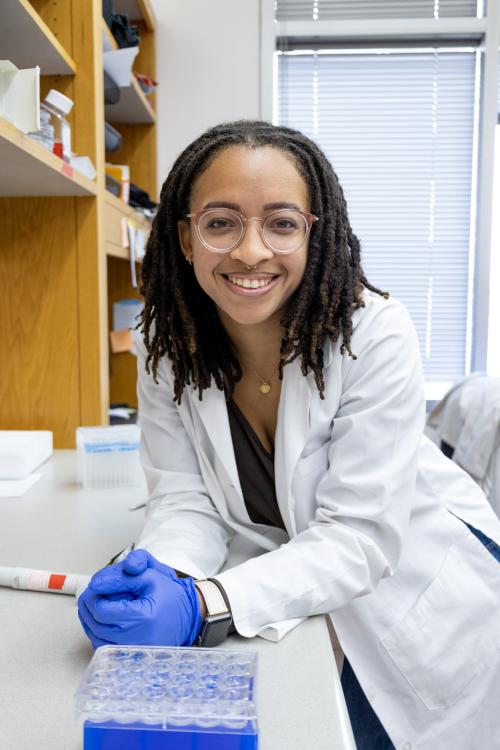

As a master’s student at Duke, Paris Brown developed a love of the human brain. Now, she’s building one.
When she first came to Duke, Brown spent every free moment in Professor Shyni Varghese’s lab. Although she didn’t come from a biomedical engineering background, Brown was on the lookout for an interesting project. So, Varghese recommended a project that piqued her interest: use organ-on-a-chip technology, miniaturized model systems of a human organ, to investigate the blood-brain barrier and responses to inflammation. Through that project, Brown discovered her love of the human brain.
“There’s just a lot going on in your head that you don’t think about, like, all these signals and synapses going on so quickly throughout your brain,” Brown said. “It’s like a little factory. A very efficient factory, but organic. It’s just really cool to me.”
That experience also led her down the unexpected path of pursuing a doctoral degree. Brown recently wrapped up her first year as a biomedical engineering Ph.D. candidate at Duke. She is also a Sloan Scholar and president of Sisters in STEM.
“I honestly didn’t expect for this to happen at all, I didn’t really expect to get my Ph.D.,” she said. “But, my PI really convinced me. I think she just saw my potential. Even though I didn’t have a strong background in it, I was still learning as much as I could and as fast as I could.”
Continuing her work at the Varghese Lab and her investigation into pain and neural inflammation, Brown is now using stem cells to create a representation of the human brain.
“A lot of methods to study the brain are very invasive,” she said. “Like, you have to stick probes to people’s heads and behind their ears. It can cause infection and even death. Other methods are mice studies, but those a lot of the time don’t really translate well to humans.”
Brown hopes that her model of the human brain will help make research on the brain more humane, specifically in regard to therapeutics research.
To make the brain model, Brown is culturing clumps of neural stem cells into cells such as neurons and astrocytes, cells that help nerve cells develop. These cells are then embedded together to form an organoid that can serve as a model of a human brain. So far, Brown has cultured a forebrain, and is working on a midbrain and hindbrain. She will then combine them for a full model of the human brain.
The different cell types within this brain model are stained with different colors. Under a microscope, she’s able to differentiate between neurons, astrocytes, and other cells.
She will eventually culture this brain model with other types of cells that receive sensory information, such as pain, to see how they interact with one another. She would also like to incorporate wearable sensors into the organoid to see levels of serotonin and dopamine in the brain after an injury or a feeling of pain.
Brown hopes this model will provide a foundation to be used for therapeutics and to test drugs for pain.
“I want to do this because we can study the brain without using a human brain sample or an animal model,” Brown said. “We can just directly get cells from the patient, which is really good. It will kind of pave the pathway for a more accurate representation of how the human brain is working, without actually drilling in somebody’s head.”
Top image: The brain model that Paris Brown is developing. The green portions represent the vasculature channel, and the red is the brain chamber. (Photo courtesy of Paris Brown)